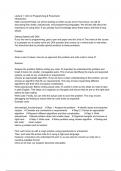Class notes
DSA notes lecture 1-30
- Course
- Institution
The DSA works in the framework of public-key cryptosystems and is based on the algebraic properties of modular exponentiation, together with the discrete logarithm problem, which is considered to be computationally intractable. The algorithm uses a key pair consisting of a public key and a private ...
[Show more]



